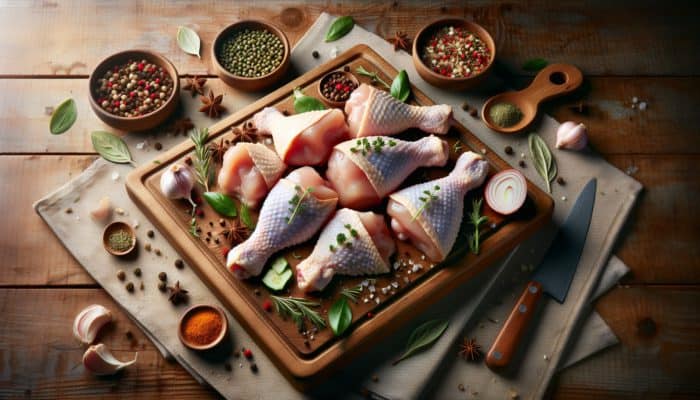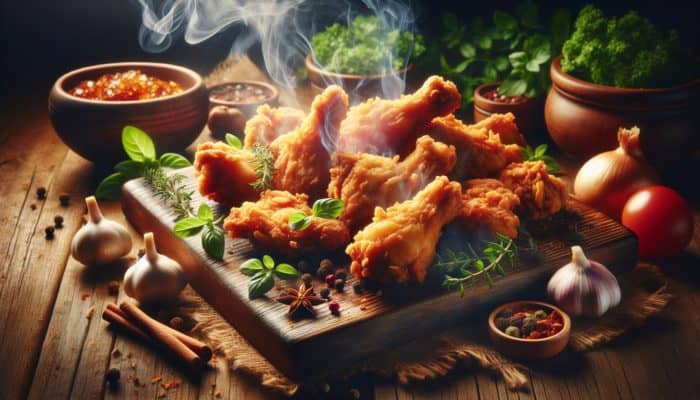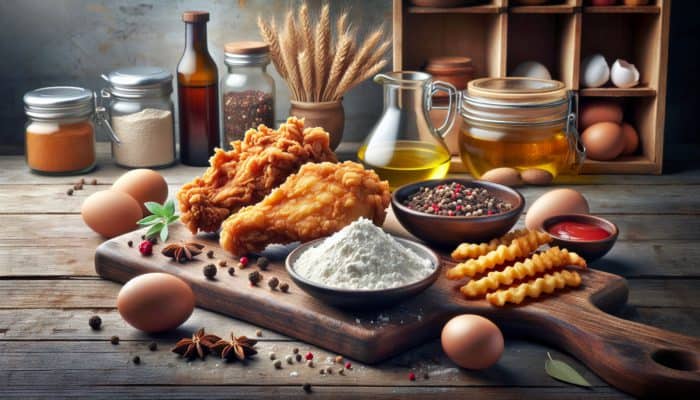Master the Art of Perfectly Fried Chicken with These Expert Techniques
Identify the Best Chicken Cuts for Delicious Frying Results

Selecting the right chicken cuts is a fundamental step toward crafting delectable fried chicken that will impress everyone. Cuts like drumsticks and wings are especially popular due to their perfect balance of juicy meat and crispy skin, both of which create an enticing crispiness that’s hard to resist. Always opt for fresh, high-quality chicken, as the freshness directly influences the flavour and texture of your fried masterpiece. To ensure you’re sourcing the best, consider visiting your local butchers or reputable suppliers. This thoughtful selection process guarantees each piece stays juicy and tender throughout cooking, delivering the succulent bites that fried chicken aficionados adore.
The skin of the chicken is essential during frying, functioning as a barrier that locks in moisture while allowing the exterior to develop a perfect golden-brown, crispy finish. When it comes to frying chicken breasts, exercise caution, as they have a tendency to dry out rapidly. To combat this, think about marinating or brining these cuts to help retain their juiciness. Ultimately, the key is to choose chicken pieces that correspond with your frying technique and desired outcomes, guaranteeing that each bite presents a delightful crunch paired with a juicy, tender center.
Understanding the Importance of Brining for Exceptional Fried Chicken
Integrating the method of brining into your cooking routine can transform your fried chicken from ordinary to extraordinary. Soaking the chicken in a mixture of water, salt, and sugar significantly boosts its moisture levels while also enriching its flavour. This straightforward yet effective brine seeps into the chicken, infusing it with mouthwatering taste and ensuring it remains juicy during the frying process. While creating a basic brine with just water, salt, and sugar is effective, consider enhancing it with herbs, spices, or a dash of hot sauce to increase the complexity of flavours.
For the best results, allow the chicken to soak in the brine for a minimum of one hour, though a soaking duration of 4 to 12 hours is ideal for deeper flavour absorption and moisture retention. After completing the brining process, lightly rinse the chicken to eliminate excess salt and then pat it dry with paper towels. This step is crucial, as any residual moisture can impede the frying process and result in a less crispy exterior.
Achieving the Ideal Oil Temperature for Perfectly Fried Chicken
Maintaining the correct temperature during frying is one of the key elements to creating perfectly fried chicken. Aim to keep the oil temperature between 350°F and 375°F (approximately 175°C to 190°C) to achieve that sought-after golden, crispy surface. If the oil gets too hot, the chicken may burn on the outside before it cooks thoroughly; on the flip side, if the oil is too cool, the chicken will absorb excess oil, leading to a greasy texture.
A reliable thermometer is indispensable for accurately tracking the oil’s heat. Investing in a deep-fry thermometer or an infrared thermometer can provide quick and precise measurements. When frying the chicken, avoid overcrowding the pan, as this can significantly lower the oil temperature. If necessary, fry in batches to ensure each piece is cooked thoroughly. After frying, let the chicken rest on a wire rack instead of paper towels; this helps maintain its crispiness by preventing moisture accumulation.
Insider Tips for Crafting Irresistibly Crispy Fried Chicken

Expert Techniques for Achieving Crunchy Fried Chicken
Numerous professional chefs and culinary experts have refined their methods for crafting the ultimate crispy fried chicken. These renowned chefs often combine high-quality ingredients with specific cooking techniques to amplify both flavour and texture. For example, culinary icons such as David Chang and Marcus Samuelsson endorse the use of buttermilk brines to effectively tenderize the meat while enriching it with robust flavour.
Here are some key techniques employed by professionals that can help replicate similar success in your own kitchen:
- Utilizing buttermilk or yogurt marinades for the utmost tenderness.
- Using a seasoned flour mixture to deepen the flavour profile.
- Implementing a double frying method for added crunchiness.
- Allowing the batter to rest before application for better adherence.
- Combining various oils for frying to enhance the flavour.
- Incorporating a diverse array of spices into the coating for a richer taste.
- Carefully timing the frying process to avoid overcooking.
- Adjusting the thickness of the coating according to personal preference.
These techniques have been rigorously tested in kitchens worldwide, proving effective in delivering fried chicken that excels in both flavour and texture, ensuring your culinary creations will leave a lasting impression.
Your Comprehensive Guide to Crafting Perfect Fried Chicken at Home
To replicate restaurant-quality fried chicken in the comfort of your kitchen, follow these actionable, step-by-step instructions:
1. Select Your Chicken Cuts Wisely: Start by choosing high-quality chicken cuts, preferably skin-on, to enhance that desired crunch.
2. Prepare Your Brine: Create a brine solution using water, salt, sugar, and any additional flavourings you enjoy. Allow the chicken to soak for a minimum of one hour, or longer for more pronounced flavour infusion.
3. Mix Your Batter: In a mixing bowl, combine flour, Cornstarch, and spices. The batter should be thick enough to adhere to the chicken without being overly heavy or clumpy.
4. Heat Your Oil: In a deep fryer or large pot, heat your selected oil to between 350°F and 375°F. Use a thermometer to ensure precise measurements.
5. Coat Your Chicken: After removing the chicken from the brine, pat it dry, then dip it into the batter mixture, ensuring even coverage over each piece.
6. Fry in Batches: Carefully place the chicken into the hot oil, making sure not to overcrowd the pan. Fry until golden brown and thoroughly cooked, which generally takes around 12 to 15 minutes, depending on the sizes of the cuts.
7. Let It Rest and Serve: Once fried, allow the chicken to rest on a wire rack to maintain its crispiness before serving to eagerly awaiting guests.
By following these steps, home cooks can effectively circumvent common pitfalls such as greasy or undercooked chicken, ensuring scrumptious results every time.
Perfecting Batter Consistency for Optimal Texture

The consistency of your batter is a pivotal aspect that directly affects the texture of your fried chicken. A thinner batter typically yields a lighter, airier crunch, while a thicker batter results in a heartier coating that enhances crunchiness. Ultimately, your choice of batter thickness should align with your personal preferences and desired outcomes.
When creating your batter, aim for a consistency akin to pancake batter—thick enough to cling to the chicken but not so thick that it overwhelms the meat. Many experts suggest experimenting with different ratios to find the ideal balance that caters to your taste. For instance, incorporating cornstarch into your flour mix can enhance crispiness due to its lower moisture content.
Allowing the batter to rest for 15 to 30 minutes prior to use can also significantly improve its adhesion to the chicken. This resting phase helps the gluten in the flour relax, resulting in a smoother coating. Testing the batter’s thickness by dipping a piece of chicken can help you determine whether adjustments are necessary for the desired texture.
Crafting the Ultimate Batter for Fried Chicken
Essential Ingredients for Creating an Outstanding Batter
The selection of ingredients is critical when striving to create the perfect batter for frying chicken. A combination of flour, cornstarch, and an array of seasonings typically forms the foundational mix. While flour provides the necessary structure, cornstarch contributes a lighter texture. The seasonings are where you can enhance the batter’s flavour profile significantly.
Consider experimenting with the following essential batter ingredients to discover your ideal combination:
- All-purpose flour as the primary base.
- Cornstarch for added crispiness in the coating.
- Baking powder for a lighter texture.
- Salt to elevate overall flavour.
- Black pepper for a subtle touch of heat.
- Garlic powder for added depth and aroma.
- Paprika for vibrant colour and a hint of smokiness.
- Herbs such as thyme or oregano for aromatic notes.
These ingredients can be adjusted based on your personal taste or regional culinary influences. For a unique twist, think about adding spices that reflect local traditions, enriching the overall flavour profile of your fried chicken dish.
Impact of Batter Thickness on Frying Outcomes
Indeed, the thickness of the batter plays a significant role in the final texture of your fried chicken. A thicker batter tends to create a more substantial, crunchier exterior, while a thinner batter may produce a lighter and more delicate coating.
Home cooks should engage in a bit of experimentation to find their preferred batter thickness. For a crunchier finish, strive for a batter that maintains its shape slightly when dipped. Conversely, if you desire a lighter result, opt for a thinner consistency that flows smoothly off the chicken. This exploration will help you uncover the texture that best appeals to your palate.
Furthermore, when using a thicker batter, be sure to fry at a slightly elevated temperature to ensure it crisps up quickly without absorbing excessive oil, which can lead to a greasy outcome.
Optimal Resting Period for Batter Performance
Permitting your batter to rest for 15 to 30 minutes can significantly enhance its frying performance. This resting period allows the ingredients to meld together, improving adhesion to the chicken. A rested batter is also less likely to separate during frying, ensuring an even and consistent coating.
During this time, the gluten within the flour relaxes, resulting in a smoother and more uniform application. It’s crucial to keep the batter covered during this period to prevent oxidation and maintain moisture.
If you’re pressed for time and cannot allow your batter to rest, a quick whisk can reintroduce air into the mixture. However, for optimal results, always strive to allow for a proper resting period whenever feasible.
The Role of Temperature in Batter Performance During Frying
The temperature of both the batter and the oil can greatly affect the results of your frying. Applying cold batter to hot oil can produce a crisper finish, as the sudden temperature change causes moisture in the batter to evaporate quickly, resulting in a crunchy exterior.
Conversely, if the batter is at room temperature, it may not set as quickly, leading to a softer texture. Therefore, it is advisable to allow your batter to warm slightly after refrigeration before frying, though it should not reach full room temperature.
In addition, keeping the oil temperature within the ideal range of 350°F to 375°F is vital for optimal results. If the temperature is too low, the chicken will absorb excess oil; if it’s too high, the batter may burn before the chicken is fully cooked. Always use a thermometer to accurately monitor the oil temperature throughout the frying process.
Selecting the Right Oil for Frying Chicken
Best Oils for Achieving Perfect Fried Chicken
The choice of oil can dramatically influence the quality of your fried chicken. Oils possessing high smoke points and neutral flavours are typically recommended for frying. Popular options include peanut oil, canola oil, and vegetable oil. These oils can withstand high temperatures without breaking down, which is essential for achieving that coveted crispy finish.
When selecting your oil, also consider your dietary preferences. For instance, while olive oil has a lower smoke point, it can impart a distinctive flavour. If you have nut allergies, canola oil serves as an excellent alternative. Each type of oil has unique characteristics that can influence both the frying process and the final taste of the chicken.
Always ensure your oil is fresh and not excessively reused, as old oil can carry undesirable flavours and adversely affect the quality of your fried chicken. Maintaining high-quality frying oil is essential for achieving the best results in your culinary endeavors.
The Influence of Oil Temperature on Frying Results
The temperature of the oil is a critical factor in cooking chicken to perfection. Maintaining the oil at the correct temperature guarantees even cooking and prevents the chicken from soaking up too much oil, which can result in a greasy finish.
If the oil temperature is too low, the chicken will cook slowly, allowing it to absorb excess oil and become overly greasy. Conversely, if the oil is too hot, the exterior may char before the chicken is cooked through. This highlights the necessity of using a thermometer to closely monitor oil temperature.
Consistency is key once the chicken is placed in the oil. Avoid overcrowding the frying vessel, as this can drastically lower the temperature and lead to inconsistent cooking. Fry in batches if necessary to ensure uniform results across all pieces.
Is It Possible to Reuse Oil After Frying Chicken?
Yes, reusing frying oil is certainly possible, but it is crucial to strain it properly to eliminate any debris and particles that could alter the flavour of future batches. Allow the oil to cool completely before straining it through a fine mesh sieve or cheesecloth into a clean container.
Store the strained oil in a cool, dark place to extend its shelf life. It is advisable to reuse frying oil only a couple of times while closely monitoring its quality. Look out for any off-smells or colour changes, which may indicate that the oil has deteriorated.
With proper storage and careful observation, reused oil can be a practical choice, helping to minimize waste while still producing delicious fried chicken.
How Does Oil Selection Affect the Flavour of Fried Chicken?
The type of oil you choose for frying can significantly influence the overall flavour profile of your fried chicken. Neutral oils like canola or vegetable oil allow the chicken’s natural flavours to shine, while oils with stronger profiles, such as sesame or olive oil, can impart unique nuances to the dish.
When experimenting with flavoured oils, it’s essential to consider how they complement the spices or marinades used. For example, frying chicken in peanut oil can introduce a subtle nutty flavour that pairs wonderfully with Asian-inspired dishes.
Understanding the flavour profiles of various oils enables creative experimentation, allowing you to develop a distinctive twist on classic fried chicken recipes that reflect your personal culinary style.
Health Considerations of Different Oils
The health implications associated with various frying oils primarily depend on their fatty acid profiles. Oils high in monounsaturated and polyunsaturated fats, such as olive or avocado oil, are often considered healthier options due to their positive effects on heart health.
Conversely, oils rich in saturated fats, like palm oil, should be utilized sparingly. The frying process can also alter the nutritional content; for instance, oil that degrades during frying may produce harmful compounds.
Choosing oils with health-conscious properties can enhance your fried chicken without compromising flavour. Always take into account the nutritional aspects when selecting oils for cooking, making informed choices that align with your health objectives.
Techniques for Achieving a Crunchy Coating
The Benefits of Double Frying for Texture
Double frying is a technique that can elevate your fried chicken to new heights of crunchiness. This method involves an initial frying at a lower temperature to cook the chicken through, followed by a second fry at a higher temperature to achieve that desirable crispy exterior. This approach is a favourite in professional kitchens due to its remarkable results.
During the double frying process, the first fry should occur at around 325°F (approximately 160°C) until the chicken is cooked internally. After allowing it to rest, increase the oil temperature to about 375°F (190°C) before returning the chicken to the oil for the second fry. This step locks in moisture while creating an irresistible crunch that is hard to resist.
After the second frying, place the chicken on a wire rack to ensure its crispiness is preserved. This method not only enhances texture but also allows the flavours to fully develop, resulting in a satisfying eating experience that will impress anyone who tries it.
Enhancing Crunch with Spices in Fried Chicken
Spices play a crucial role in enhancing the crunch of fried chicken, adding both flavour and texture to the coating. Specific spices, such as paprika and garlic powder, can help create a robust crust while enriching the overall flavour profile.
When adding spices to your batter, consider using a blend of dry spices that complement one another. For instance, combining smoked paprika, cayenne pepper, and garlic powder creates a flavourful base that enhances both the crunch and overall taste of the chicken.
Experimenting with different spice blends can yield unique variations. The key is to maintain a balanced flavour; too many spices can overpower the chicken, while too few may result in a bland coating. Finding the right mix not only elevates the crunch but also personalizes your fried chicken experience.
The Impact of Coating Type on Overall Quality
Indeed, the type of coating applied to fried chicken significantly influences its final texture and flavour. Traditional flour-based coatings provide a classic crunch, but numerous alternatives can yield diverse outcomes.
For instance, using breadcrumbs, particularly panko breadcrumbs, can impart a unique texture, as they are larger and coarser than regular breadcrumbs, resulting in a lighter and crispier finish. Additionally, incorporating crushed cornflakes or potato chips can add an intriguing twist in texture and flavour.
Exploring different coating options opens up a world of possibilities. Consider combining various textures for a multi-dimensional crunch or utilizing unique ingredients that reflect your culinary style. The coating not only serves as a vessel for flavour but also significantly contributes to the overall dining experience.
Successful Techniques for Crafting Crispy Fried Chicken
Proven Methods from Acclaimed Cooks
Numerous chefs and home cooks have shared their successful fried chicken recipes, highlighting various strategies for achieving that ideal crunch. For example, the renowned Roscoe’s House of Chicken and Waffles is celebrated for its marinated chicken, soaked in a spice blend for hours before frying.
Here are some effective strategies utilized by expert cooks:
- Marinating chicken overnight for intensified flavour.
- Combining flour and cornstarch for a superior coating.
- Employing a vinegar-based brine for tenderization.
- Frying in small batches to maintain optimal oil temperature.
- Allowing chicken to rest after frying for maximum crispiness.
- Using a deep fryer for consistent temperature control throughout the cooking process.
- Experimenting with gluten-free flours for alternative coatings.
- Pairing fried chicken with flavourful dipping sauces to enhance the meal.
These strategies have been rigorously tested and proven to yield outstanding results, making them invaluable for anyone aspiring to master the art of fried chicken preparation.
Guidelines for Ensuring Consistent Results in Fried Chicken Preparation
Achieving consistent outcomes in fried chicken preparation necessitates attention to detail and adherence to specific techniques. Follow these guidelines for reliable results:
1. Consistency in Ingredients: Always measure your ingredients accurately. Even minor variations can alter the batter’s consistency and flavour.
2. Stable Oil Temperature: Utilize a thermometer and fry in small batches to ensure the oil temperature remains steady throughout the cooking process. Adjust the heat as necessary.
3. Timing is Everything: Adhere to recommended frying times for each chicken cut, checking for doneness using a meat thermometer (aim for 165°F/74°C internal temperature).
4. Incorporate Resting Periods: After frying, allow the chicken to rest. This step is critical for maintaining crispiness by preventing steam buildup.
5. Document Your Process: Keep detailed notes on your frying method, including ingredient ratios and timings. This documentation will help you replicate your successes in the future.
By implementing these steps and focusing on the finer details, home cooks can consistently achieve delicious fried chicken time after time.
Expert Suggestions for Effective Marinating Techniques
Marinating is a fundamental technique that enhances both the flavour and texture of fried chicken. The right marinade can tenderize the meat, resulting in a juicier final product. Experts often recommend using acidic components, such as buttermilk or yogurt, which not only impart flavour but also help break down proteins, making the chicken more tender.
Different marinating techniques can yield various results. For example, marinating in a blend of buttermilk, hot sauce, and spices overnight creates chicken that is deeply flavoured and moist. Alternatively, a dry rub marinade can provide a punch of flavour while allowing the chicken to maintain its crispiness during frying.
The key lies in balancing the marinade’s flavours with the coating. A well-marinated chicken can withstand bold spices in the coating, resulting in an impressive taste experience. Always remember to pat the chicken dry before applying the coating to ensure effective batter adherence.
Best Practices for Serving and Storing Your Fried Chicken
Ideal Serving Methods for Fried Chicken
Fried chicken is best enjoyed hot and fresh to fully appreciate its crispy texture and rich flavour. Presentation can greatly enhance the dining experience; consider serving the chicken on a rustic wooden board or an elegant platter. Pair it with sides that complement its richness, such as creamy coleslaw, buttery mashed potatoes, or tangy pickles.
Don’t hesitate to think outside the box about serving styles. Fried chicken can shine in sliders, mini sandwiches, or even atop a salad for a lighter meal. Accompany it with a variety of dipping sauces—think spicy mayo, honey mustard, or classic hot sauce—to elevate the flavour experience even further.
Aim for a presentation that showcases your culinary skills while preserving the comfort and familiarity that fried chicken embodies.
Storing Fried Chicken to Maintain Quality
Yes, you can effectively store fried chicken, but there are methods to ensure it retains its texture and flavour. Allow the chicken to cool completely before transferring it to an airtight container, which helps prevent moisture accumulation and sogginess.
Store the fried chicken in the refrigerator for up to 3-4 days. When it’s time to reheat, avoid using the microwave, as this can lead to a rubbery texture. Instead, place the chicken on a baking sheet in a preheated oven (around 375°F/190°C) and heat until warmed through, approximately 15-20 minutes. This method helps restore some of its crispiness.
If you plan to freeze the chicken, ensure it’s completely cooled, tightly wrapped in foil or freezer bags, and consumed within a month for the best quality.
Creative Ways to Serve Fried Chicken
There are countless innovative ways to present fried chicken that go beyond traditional servings. For example, consider crafting fried chicken sliders using mini brioche buns, topped with spicy slaw and a drizzle of sriracha mayo. Another idea is to serve the chicken on a fresh garden salad, accompanied by crispy bacon and a zesty vinaigrette.
You might also incorporate fried chicken into breakfast by serving it atop waffles, drizzled with maple syrup for a delightful sweet and savoury experience. Another unique option is to create fried chicken tacos, using corn tortillas, fresh salsa, and avocado to complement the crunch.
Experimenting with various accompaniments and presentations can elevate your fried chicken dish, transforming it into a versatile option suitable for any meal or occasion.
Frequently Asked Questions About Fried Chicken
How to Keep Fried Chicken Crispy After Cooking?
To maintain the crispiness of your fried chicken post-cooking, place it on a wire rack instead of paper towels. This technique promotes air circulation and prevents steam from softening the coating, ensuring a satisfying crunch.
How Long Can Leftover Fried Chicken Be Safely Stored?
Leftover fried chicken can be safely stored in the refrigerator for up to 3-4 days. Ensure it is placed in an airtight container to help preserve its freshness and texture.
Which Is Better for Frying Chicken: Cast Iron or a Deep Fryer?
Both methods are excellent; however, a deep fryer offers more consistent temperature control, while cast iron skillets provide a classic frying experience with superior heat retention and flavour development.
Can I Use Gluten-Free Flour for Fried Chicken?
Yes, gluten-free flour blends can be successfully utilized to create a batter for fried chicken. Look for blends that combine a mixture of flours for the best texture and taste.
Why Should Chicken Be Brined Before Frying?
Brining chicken infuses moisture and flavour into the meat, enhancing its juiciness and tenderness during frying, which results in a more enjoyable eating experience.
How to Make Fried Chicken Healthier?
To create a healthier version of fried chicken, consider baking instead of frying, using air fryers, or selecting lean cuts of chicken. Alternatively, opt for healthier oils when frying to reduce fat content.
What Is the Ideal Oil Temperature for Frying Chicken?
The ideal oil temperature for frying chicken is between 350°F and 375°F (approximately 175°C to 190°C) to achieve a crispy exterior while ensuring the chicken cooks thoroughly inside.
Is Overnight Marinating Beneficial for Chicken?
Yes, marinating chicken overnight is highly beneficial for developing deeper flavours and tenderness. Just ensure your marinade is balanced to avoid overwhelming the chicken with excessive seasoning.
What Are Some Great Sides to Serve with Fried Chicken?
Excellent sides that complement fried chicken include coleslaw, mashed potatoes, cornbread, biscuits, and pickles. These sides beautifully balance the richness of the chicken, creating a well-rounded meal.
How to Determine When Fried Chicken Is Fully Cooked?
Fried chicken is considered done when its internal temperature reaches 165°F (approximately 74°C). Using a meat thermometer is the most reliable method to ensure it is thoroughly cooked and safe to eat.
Join Us on Facebook for More Culinary Inspiration!
The post Uncovering the Secrets to Crispy Fried Chicken: Universal Techniques appeared first on https://cookinggods.com
The Article Crispy Fried Chicken Secrets: Universal Cooking Techniques Was Found On https://limitsofstrategy.com

